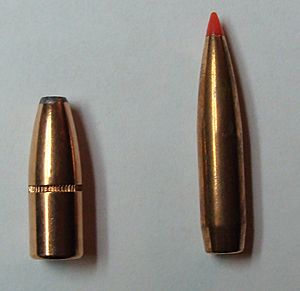Ballistic coefficient facts for kids
The ballistic coefficient (often called BC) of a bullet tells us how well it can push through the air when it flies. Think of it like how slippery a car is in the wind. A high BC means the bullet is very good at cutting through the air. This helps it keep its speed for longer. It also means the bullet will have more power when it hits its target.
A bullet's BC depends on its mass, its diameter (how wide it is), and how much air resistance it creates. Ballistic coefficients are usually measured in pounds per square inch (lb/in²) or kilograms per square meter (kg/m²). Bullet makers often just give the number without the units. BC values for common bullets can be as low as 0.12 or as high as 1.00.
Contents
How Ballistic Coefficient Affects Bullets
A bullet with a high BC will travel farther than one with a low BC. This is because it keeps its speed better and isn't pushed around as much by the wind. It also "shoots flatter," meaning it doesn't drop as much over long distances.
When hunting, a higher BC is very helpful. A flatter flight path means the shooter is less likely to miss. They don't have to guess as much about how far the bullet will drop. This difference becomes much more important at longer distances. For example, at 550 yards (about 500 meters), a high BC bullet might hit a foot (30 cm) higher than a low BC bullet.
A high BC bullet also reaches the target faster and with more energy. Because it gets there quickly, it's less affected by strong winds blowing across its path.
Different Types of Bullets and Their BCs
Sporting bullets usually have BCs between 0.12 and just over 1.00. The higher the number, the better the bullet cuts through the air. Very special bullets can be made with BCs even higher than 1.10.
Bullet makers often offer different weights and shapes for the same size bullet. Bullets that are heavier for their size, have a pointed tip (called a spitzer), and a sloped back end (called a boat tail) usually have high BCs. Lighter bullets with flat backs and rounded or flat noses have lower BCs.
Some popular hunting bullets known for their high BCs include the .25-06 Remington, .270 Winchester, and .284 Winchester. For very long-range shooting (over 1000 meters), larger bullets like the .338 Lapua Magnum and .50 BMG are used. They have very high BCs.
Measuring Ballistic Coefficient
Ballistic coefficients are not always exact numbers. They are averages. This is because things like air density (how thick the air is) can change how a bullet flies.
To find a very accurate BC, special equipment like Doppler radar is needed. This radar tracks the bullet's flight. Governments and professional experts use this equipment to get real-world information on how bullets fly.
Just like in any science experiment, bullets are fired many times. The measurements are then averaged to get the bullet's BC.
Related pages
- External ballistics - This is about how a projectile (like a bullet) behaves when it's flying through the air.
- Trajectory of a projectile - The path a projectile takes. Ballistic coefficient helps calculate this path. It's an easy way to understand how air resistance affects a bullet.
Free BC Calculators
There are free computer programs that can help you calculate ballistic coefficients if you know other details about the bullet.
Images for kids
See also
 In Spanish: Coeficiente balístico para niños
In Spanish: Coeficiente balístico para niños




